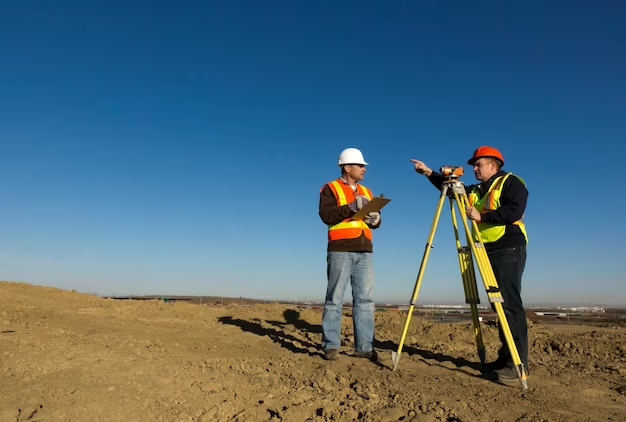When it comes to the domain of property and land possession, having a comprehensive comprehension of the intricacies and essential aspects surrounding land surveys is vital. One survey type that particularly shines for its comprehensive nature is ACSM Land Title Surveys or otherwise referred to as ALTA Surveys. The aim of this article is to provide an exhaustive insight into ACSM Land Title Surveys by highlighting their significance, procedure, and advantages.
The Importance of ACSM Land Title Surveys

The significance of ACSM surveys in real estate transactions cannot be overstated as they adhere to the standards established by both ALTA and ACSM. These all-encompassing surveys present a thorough analysis of several facets of a property, which proves vital for sellers, buyers, title insurance firms and lenders alike.
Key Features of ACSM Land Title Surveys
Detailed Property Boundaries
The precision of ACSM land title surveys in defining property boundaries is widely recognized, effectively minimizing the risk of conflicts concerning property lines. As a result, all parties involved obtain an unquestionable comprehension regarding the extent and limitations thereof.
| Feature | Description |
| Precise Boundary Marks | Exact measurements and markers for property boundaries. |
| Boundary Overlays | Overlay of property boundaries on a detailed map. |
| Legal Description | A written legal description of the property’s bounds. |
Identification of Improvements
Through meticulous surveys, ACSM comprehensively identifies all property improvements such as buildings, roads, fences and other structures. This information plays a significant role in assessing the value of the asset and identifying potential encumbrances.
| Feature | Description |
| Building Layout | Exact locations and dimensions of all structures. |
| Roadways | Clear identification of roads and driveways. |
| Fences | Marking the location and type of property fencing. |
Easements and Rights-of-Way
The surveys conducted by ACSM aim to identify easements and rights-of-way that could potentially impede property ownership or development plans. These legal restrictions can substantially influence the usage of land as well as its market worth.
| Feature | Description |
| Easement Locations | Identification and documentation of all easements. |
| Right-of-Way Data | Clear representation of any rights-of-way on the land. |
Zoning Classification
The data contained in ACSM Land Title Surveys, such as the property’s zoning classification and possible land use limitations, is crucial for both purchasers and developers. It enables them to acquire a better comprehension of what kind of development would be allowed on the premises.
| Feature | Description |
| Zoning Classification | Identification of the property’s zoning category. |
| Land Use Restrictions | Notation of any restrictions imposed by zoning. |
Potential Encroachments
Identifying encroachments is vital to ACSM surveys as they reveal any structures or features that intrude on the property boundaries. This can prevent legal disputes and potential complications in the future.
| Feature | Description |
| Encroachment Data | Clear identification of any encroachments. |
| Boundary Markers | Placement of markers where encroachments occur. |
The Significance of ACSM Land Title Surveys

ACSM Land Title Surveys are of paramount importance in real estate transactions for several reasons:
- Risk Mitigation: ACSM surveys minimize legal disputes and the likelihood of financial losses for property owners by precisely defining their property boundaries, detecting encroachments, and emphasizing easements.
- Informed Decision-Making: ACSM surveys provide comprehensive data on zoning classification and land use restrictions, enabling buyers and lenders to make informed decisions about property transactions.
- Title Insurance: Title insurance companies trust ACSM surveys to evaluate the liabilities linked with covering a property’s title, essentially securing purchasers and creditors against unexpected complications.
- Legal Compliance: In order to ensure adherence to local zoning laws, land use regulations and property rights during real estate transactions, ACSM surveys facilitate legal compliance.
- Property Development: With full awareness of the precise land demarcations and possible constraints, property developers as well as builders can undertake development schemes with assurance.
The Process of Conducting an ACSM Land Title Survey
The process of conducting an ACSM land title survey involves several critical steps:
Research
To conduct an ACSM land title survey, the initial step is conducting a thorough investigation. Surveyors meticulously scrutinize historical records and past property surveys to obtain vital information regarding property limits, easements, rights-of-way and any intrusive elements. This phase of research is critical in acquiring all relevant data necessary for accurate results.
- Historical Records: To comprehend a property’s ownership history, surveyors analyze historical records such as documents, deeds, and land titles.
- Previous Surveys: Assessment of property boundary changes or discrepancies over time is conducted by analyzing past survey data.
Field Work
Conducting on-site measurements and gathering data using advanced tools through physical visitation of the property is a crucial step in ensuring accuracy and completeness when conducting an ACSM land title survey, making field work a fundamental aspect.
- GPS Technology: The use of GPS Technology allows for precise determination of property boundaries and reference points by providing incredibly accurate geographic coordinates through the Global Positioning System (GPS) technology.
- Electronic Distance Meters: Electronic Distance Meters (EDMs) are precise tools used for measuring distances between different points on a property, providing accurate boundary measurements.
- Total Stations: Total Stations, which integrate both Electronic Distance Measurement (EDM) and Theodolite functions, are commonly employed to measure angles, distances and elevations on a given property.
Analysis
Once the field data is gathered, surveyors conduct a thorough analysis of the information. This includes double-checking boundary measurements to ensure accuracy and detecting any encroachments that may exist on the property. Additionally, they assess how easements and rights-of-way might impact the land in question.
- Boundary Verification: To verify boundaries, surveyors cross-check the recently collected measurements with historical records to ensure their precision.
- Encroachment Identification: Any structures, roads or characteristics that intrude upon the property limits are acknowledged and recorded.
- Easement and Right-of-Way Assessment: The evaluation of the effects that easements and rights-of-way have on a property is conducted to ascertain their importance in land usage.
Mapping
In the ACSM land title survey process, producing an intricate map that portrays all surveyed attributes and discoveries is essential. This final step provides a crucial document for all those participating in real estate transactions.
- AutoCAD Software: The AutoCAD software is frequently employed for meticulous cartography and blueprinting, empowering the user to generate intricately-scaled diagrams that faithfully depict extensive attributes like property boundaries, edifices, and topographical characteristics.
- Layered Mapping: Surveyors utilize layered mapping in AutoCAD to arrange various elements of the property, such as easements, improvements and property lines for improved clarity and reference.
ACSM Land Title Surveys in Real Estate Transactions
ACSM land title surveys are indispensable in real estate, as they furnish crucial and comprehensive information necessary for:
Due Diligence
For any individual seeking to purchase a property, performing an extensive due diligence process is paramount. To make informed decisions prior to acquisition, ACSM Land Title Surveys offer comprehensive insight into the features and limits of the asset. Below are some ways that ACSM surveys can aid in conducting thorough due diligence:
- Property Boundaries: Accurate measurements of property boundaries minimize the likelihood of boundary disagreements and provide purchasers with clear knowledge about their purchase.
- Improvement Identification: Identifying the structures, roads and other enhancements on a property clearly helps evaluate its worth.
- Easements and Rights-of-Way: Unveiling easements or rights-of-way can prevent unforeseen obstacles or limitations.
- Zoning Information: The classification of zones and the restrictions on land use aid in informing buyers about allowable uses for the property.
Financing and Insurance
Obtaining financing and insurance for a property is contingent on the availability of accurate and detailed information. ACSM Land Title Surveys provide the necessary data to secure both financing and insurance for real estate transactions:
- Title Insurance: Title insurance companies rely on ACSM surveys to assess title risks and provide coverage, safeguarding buyers and lenders from unforeseen issues related to property ownership.
- Lender Requirements: Lenders often require an ACSM survey to ensure the property’s boundaries and improvements align with the loan collateral.
Legal Clarity
ACSM Land Title Surveys contribute significantly to resolving property disputes and clarifying ownership rights. Legal clarity is essential for a smooth and conflict-free real estate transaction:
- Dispute Resolution: In cases of boundary disputes or encroachments, ACSM surveys serve as essential evidence to resolve legal conflicts.
- Ownership Documentation: The surveys provide documented evidence of property boundaries, easements, and rights-of-way, offering legal clarity for all parties involved.
Conclusion
ACSM land title surveys, or ALTA surveys, are indispensable tools in the world of real estate. They offer unparalleled detail and accuracy, ensuring that property transactions are based on the most reliable and comprehensive data available. Whether you are a buyer, seller, developer, or investor, understanding and utilizing the insights provided by ACSM land title surveys can be the key to successful and secure property dealings.
FAQ
Q: How often should an ACSM land title survey be conducted?
A: Ideally, before any major real estate transaction or development project to ensure current and accurate information.
Q: Are ACSM land title surveys required by law?
A: While not always legally required, they are often necessary for financing, insurance, and due diligence in real estate transactions.
Q: How long does an ACSM land title survey take?
A: The timeframe can vary based on property size and complexity, typically ranging from a few weeks to several months.
Q: Can ACSM land title surveys identify subsurface features?
A: Generally, they focus on surface features, but they can include subsurface elements if specified in the scope of work.
Q: Are ACSM land title surveys expensive?
A: The cost varies depending on property size, location, and survey complexity, but they are a worthwhile investment for the detailed information provided.







